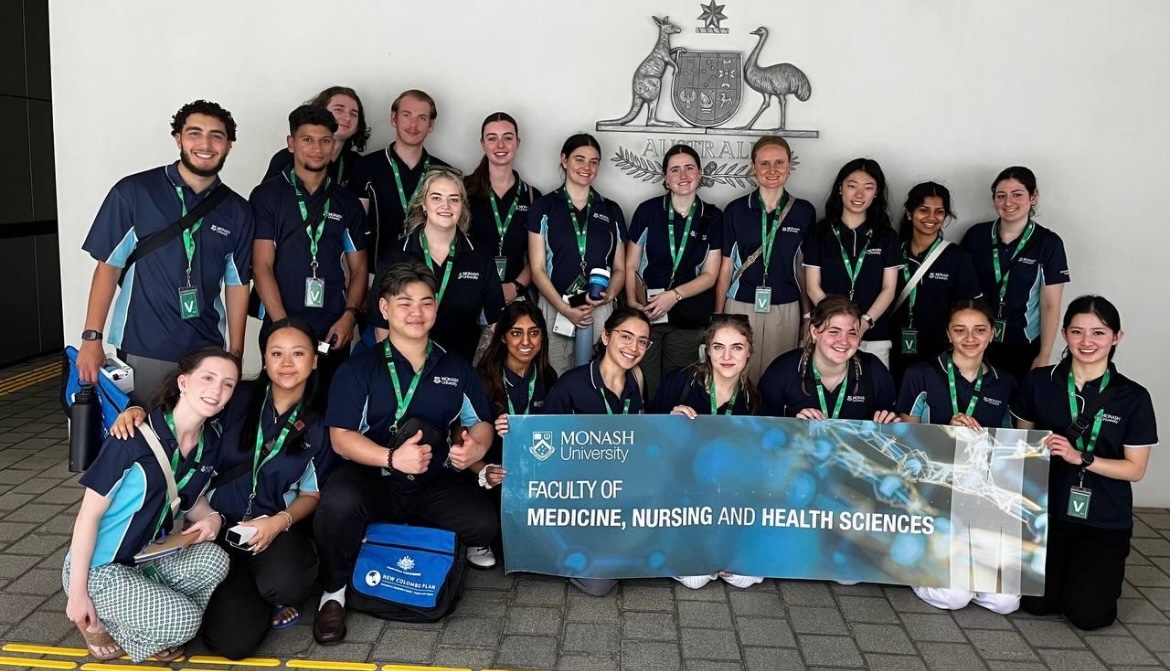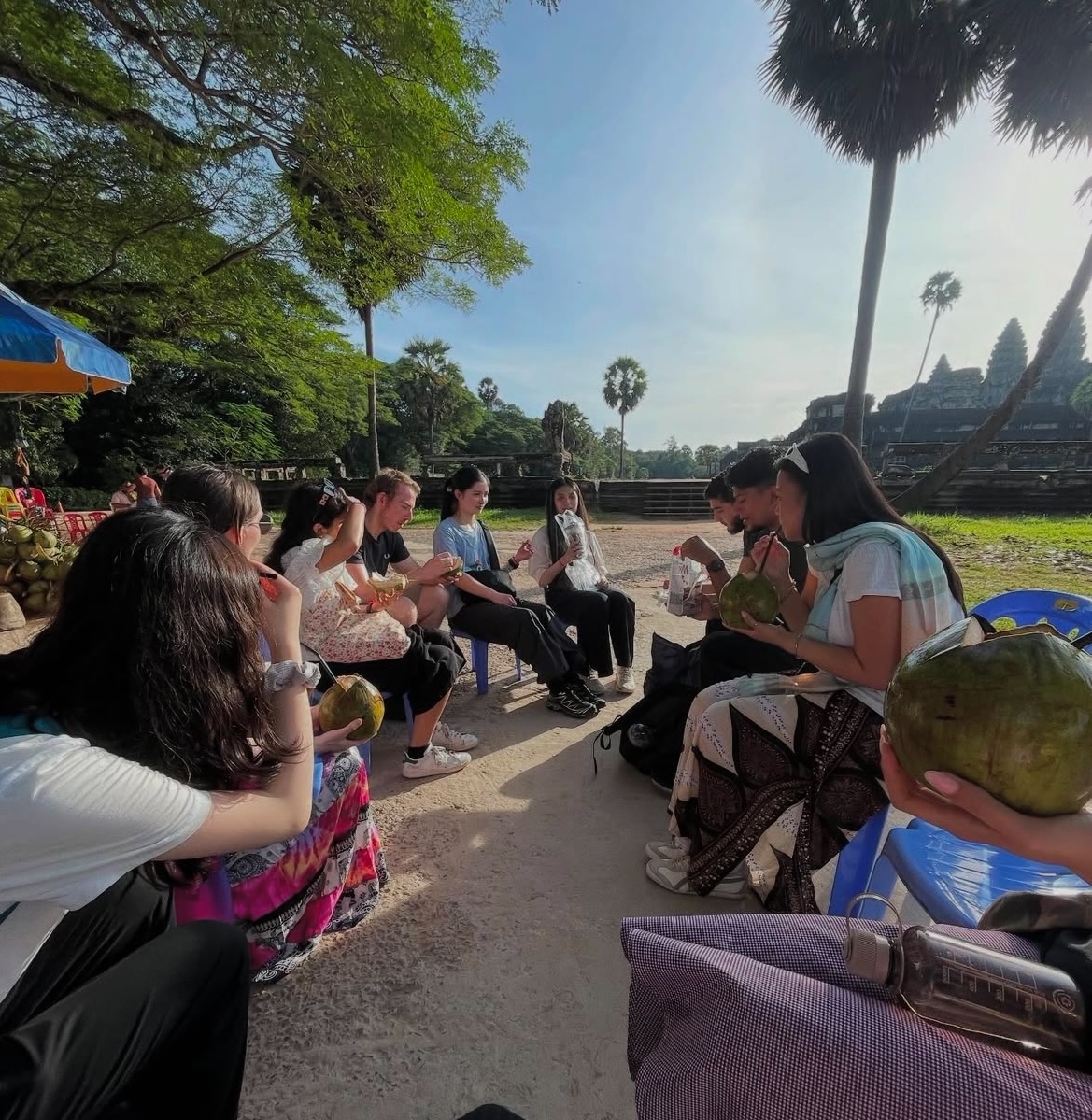
By Ben Lebbos and Kane Brooks
"Our time in Cambodia was full of incredible experiences and teachings, which we will apply to our future practice as paramedics"
In November 2024, we had the privilege of being selected to participate in the Monash University Indo-Pacific Collaborative Health Immersion Program in Cambodia.
As paramedicine students, we had the opportunity to collaborate with students from various disciplines across the Faculty of Medicine, Nursing, and Health Sciences. The goal of the program was to develop perspectives on international health, cultural capabilities, and insights into culturally appropriate healthcare services, as well as gaining a greater understanding of the roles of other health care professionals.
The trip was generously funded by the Australian Government’s Department of Foreign Affairs and Trade as part of the New-Colombo Plan, an initiative which aims to lift knowledge of the Indo-Pacific in Australia by supporting Australian undergraduate students to undertake study, language training, and internships in the region.
The trip involved site visits, university lectures, guest speakers, and cultural visits and activities, as well as hearing from industry experts to learn more about healthcare in Cambodia more broadly. We began in the Cambodian capital, Phnom Penh, where we completed several language classes, exchanged stories and cultural experiences, visited traditional markets and the Australian Embassy, and learnt about traditional medicine.
We were warmly welcomed by the Faculty of Health at Norton University, where we engaged in discussions with fellow health students about the similarities and differences of our healthcare systems, as well as the challenges faced by Cambodians in accessing healthcare.
We visited the Asia Injury Prevention (AIP) Foundation, a nonprofit dedicated to decreasing road casualties in low and middle-income countries by providing safety interventions to road users. The road crash burden in Cambodia is significant, and it was interesting to see the important initiatives being put in place by AIP to reduce the toll and was particularly relevant to paramedic practice.
We also visited the Daughters of Cambodia, an organisation that helps people leave the sex industry. Transcultural Psychosocial Organisation works to provide a comprehensive range of mental health care and support options for Cambodians. Mental health is significantly stigmatised in Cambodia, with people often chained up in their houses or described as “haunted” or “demonic”, Mothers are often blamed and seen to have passed the “illness” down to children with mental health problems.
A week later, we made the short flight to the regional centre of Siem Reap, north of Phnom Penh. We journeyed by traditional wooden boat to the giant freshwater lake Tonle Sap, which hosts a number of small floating villages. Adapting completely to the nature of the environment in which they live, locals spend most of their lives floating on the water, which is their primary source of life and food. Because of this, their diet is narrow and lacks nutritional balance, as they are unable to import other types of foods.
Soft drink is generally cheaper than water, therefore they have poor dental health. The rural location makes access to healthcare difficult, with no permanent medical help available at the lake, resulting in very poor health outcomes. The Lake Clinic is an organisation that provides the floating communities on Tonle Sap with adult and paediatric primary care, vaccinations, dental services, eye care services, antenatal care, health education, and referral, with transportation as needed, to the hospital. They fill a large gap and provide vital medical care to the people of the lake.
Angkor Hospital for Children is an independent, nonprofit paediatric healthcare hospital and organisation that works to provide either free or affordable healthcare to the children of Siem Reap. It was fascinating to see the difference between Angkor Hospital and Australian hospitals. Notably the hospital was open, lacked sterility and privacy, and the facilities were very limited - in particular, there was a hall of approximately 50 patients in beds, less than a metre apart, with no curtains. They were also poorly staffed, with more students than trained doctors and nurses. However, there was a focus on health literacy, namely classes about hygiene and healthy living, as well as nutritional cooking demonstrations - practices that could be helpful in Australia.
Cambodia's history began with the Khmer Empire, which lasted from the 1st to the 9th century, during which kings had control over the land. The monarchy continued until the colonial era in 1863, when France gained control of the country. In 1953, Cambodia regained its independence and once again became a monarchy. In 1970, it became a Republic, and in 1975, the Democratic Kampuchea party, also known as the Khmer Rouge, led by Pol Pot seized power and the country was declared to be starting at “year zero”
The Khmer Rouge sought to create a master race within Cambodia, resulting in the deaths of more than 2 million people. Those killed were either tortured and executed as enemies of the regime or died from starvation, disease or overwork. The Khmer Rouge regime ended with the Vietnamese occupation in 1979, and a coalition government was established in 1991 by the United Nations, forming present day Cambodia.
We visited Tuol Sleng, also known as S21, which was the most notorious interrogation centre established by Pol Pot. Set up in a former school, it held 17,000 prisoners with only 12 known to survive. Those who lost their lives were transported to the Killing Fields, where a mass grave was excavated and where we also visited. Many of the mass graves around Cambodia are yet to be exhumed due to the ongoing threat of unexploded landmines left by the regime.
The significant trauma faced by the Cambodian people doesn’t just affect those who directly experienced the trauma; it’s intergenerational. A deep-seeded fear of government and authority results in people fearing doctors and healthcare professionals, leading to decreased uptake of healthcare services, worsening health outcomes. Even for those wanting to use healthcare services, accessibility is limited; the seizure of goods and property has resulted in intergenerational poverty, making it difficult for individuals to access care.
It was incredibly insightful to speak to the Cambodian people, particularly the different generations, hearing their perspective of the trauma endured and how it affects people differently. There is a significant parallel between the intergenerational trauma experienced by the Cambodian people and by Aboriginal and Torres Strait Islander Peoples. The experience enabled me to consider how, in my future practice, I can provide culturally sensitive care to Indigenous Australians, as well as other marginalised and underrepresented groups.
Compared to Australian systems, pre-hospital care and the ambulance service in Cambodia are very limited. Ambulances are smaller and more basic, with limited equipment. They are typically staffed by a nurse and a driver, or just a driver. A “load and go” approach is adopted; their main role is transportation, with little pre-hospital care administered. Ambulances are generally associated with private hospitals, rather than being an independent organisation, hence they are typically only affordable for those more wealthy, further evidence of the significant health inequities.
Our time in Cambodia was full of incredible experiences and teachings, which we will apply to our future practice as paramedics. Every moment was meaningful, and we will be forever grateful.


Get unlimited access to hundreds of ACP's top courses for your professional development.
Join Now